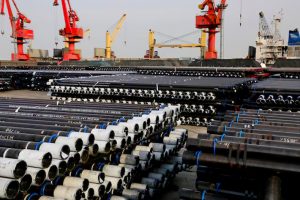(ATF) For decades, automotive production and semiconductors operated in mostly separate domains: steel, motors, glass and noise in one; silicon, switches and silent electrons whizzing about in another.
The preponderance of the world’s fleet – more than 1 billion passenger vehicles alone today – could make do with but a few hundred dollars of semiconductor content in each car; a single-digit percentage of a vehicle’s price. Meanwhile, innovations in personal computers, smartphones and data centres were the impetus behind progress at the leading edge of semiconductor technology – the chips used in cars were inexpensive and at the lagging edge.
Today, however, the collective corporate response to climate change – coupled with advances in sensing, communications and energy storage – is driving a convergence of the world’s largest manufacturing industry with the companies operating at the smallest possible scale. Auto-semi duality is here. The implications for producers, suppliers, consumers – and the planet – are profound. And the opportunities for investors are plentiful.
Driven by increasingly exacting emissions norms and enabled by technology, the globally synchronous reimagining of the automotive is happening at every part of the value chain.
Take the average passenger car of today: a petrol-fueled steel box with a centralized engine and motor, it sits idle for more than 90% of the day; and when in use, it is largely disconnected from its surroundings while being maneuvered – along a road – by a human driver with little attention to spare for any task beyond navigation. When describing the car of tomorrow, every part of that sentence will be written anew.
Electrification
First, the power source: electricity, not fossil fuels. Vehicle electrification is leading to profound changes in energy generation, distribution and storage.
Electricity from solar energy captured by polysilicon or hydrogen fuel cells will be transmitted via charging stations to cars that have shed many of the parts of legacy vehicles; they will simply not be needed, and will be replaced by fewer components but increased, distributed motorization, down to the wheels themselves.
And the tiny battery that could once be jump-started by connecting red and blue cables to another car will be replaced by a massive device that comprises a large portion of the vehicle’s cost.
As power management becomes more crucial to efficiently running a car, semiconductors will play a vital role.
Connectivity
Second, connectivity: computer vision, improving memory technologies for both DRAM and NAND, and 5G and 6G communications will transform cars from islands in a sea of vehicles into nodes on a connected web.
This web will, in time, allow the driver to become a passenger as autonomous vehicles proliferate. And it will allow all passengers to travel in a car as they would in a plane: less encumbered motion, with much more time to generate and consume ever more data.
Connectivity and self-driving vehicles will require the most intense usage of advanced semiconductor technology – and it will also be the one area where progress will be most reflexive: semiconductors will enable automotive connectivity, but the enormous demands from autos for instantaneous petabytes (not merely gigabytes or terabytes) of data capturing, processing, communicating and storing will drive innovation in semiconductors – from the lagging to the leading edge, and, perhaps, far beyond the silicon-based solutions we have today.
Utilization
Third, utilization: higher, for more vehicles. As cars and trucks become more connected, more safe and less reliant on human guidance, they will be used for longer stretches of each day, and for a broader array of purposes.
Paradoxically, this should mean more vehicles are needed, as peak demand each day will be far beyond what can be serviced with unit sales based on straight-lining recent sales trends. Again, fleet management will be driven by algorithms and data analytics, all powered by advanced computing and semiconductors.
Lastly, the path of travel: not only land, but also sky and sea. A light, autonomous, connected, emission-free vehicle need not be confined to a road. The reimagining of the car and truck of tomorrow should be total, and free of anachronism.
Computer chip sectors
What does not need reimagining, however, is the opportunity for investors: that opportunity is very real, in companies around the world. Given the near-infinite libraries of data that will be created in the coming year, the memory sector – with extremely high barriers to entry, even with new players rising in China – is one set of companies toward which all arrows point.
With heat and cost management crucial, power semiconductors are another fertile ground for capital allocation.
New materials
And with physical constraints on silicon in sight, investors should also consider making the makers of new materials – and users of new technologies, including quantum computing – an integral part of their portfolios.
Noteworthy is the fact that the locus of each of these sectors is already in – or very rapidly shifting toward – Asia.
As we lift our eyes to new horizons for moving from point A to point B, the necessity of the auto-semi duality is clear. It is fitting that in the year of the Ox – the ages-long symbol of transport in this part of the world – two industries that had been exclusive are now existing in harmony to carry the world forward.
# Vikas Pershad is Portfolio Manager at M&G Investments in Singapore
ALSO SEE:
- EV sector fast-tracked by green recovery
- Rise of EVs spells end of the oil era
- Who killed the gasoline car? The future of electric cars
- Tesla, Nio cement China’s importance to the global EV industry
- Nio signs deal with State Grid as EV drive gathers pace
- China’s Nio is worth more than Ford or General Motors























